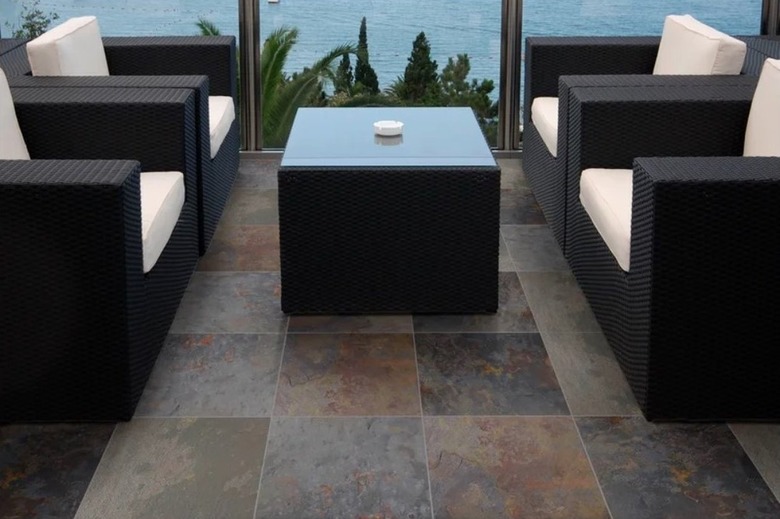Can You Color-Stain Slate Tile?
We may receive a commission on purchases made from links.
Slate tile is a lovely element in your home — or the bane of your existence. When the existing tile doesn't match your décor and ripping it all out isn't in the budget, you may wonder if you can color-stain slate tile. Paint may or may not be the best answer, especially for floors, or you can apply a translucent concrete stain and enhancing sealer to tone down and meld the colors in your stone flooring. Here's what you need to know about color-staining slate tile.
Cleaning Slate Tiles
Cleaning Slate Tiles
Before applying a stain or dye, clean the slate tiles thoroughly. Put on your gloves, safety goggles, knee pads, and a mask or respirator and open the doors and windows. Turn on kitchen and bathroom exhaust fans and put a fan in the window to pull any cleaning solution smells out of the room.
Mix warm water and dishwashing liquid or use a homemade cleaning solution or a product formulated for use on natural stone. In general, avoid using a cleaning solutions that contain chlorine bleach or an acid, such as lemon juice or vinegar. Then follow these steps:
- Mask baseboards, walls, and cabinets with painter's pretaped plastic sheeting.
- Sweep and vacuum to remove loose dirt and debris.
- Apply the cleaning solution to the slate.
- Scrub with a scrub brush or deck brush or use a floor buffer with cleaning pads to clean the tiles. Avoid using steel wool or harsh abrasives.
- Apply a grout cleaner if necessary and scrub the grout too.
- Wipe up the dirty water or use a wet/dry shop vacuum cleaner.
- Rinse with fresh water.
- Wipe with clean rags or use the wet/dry vacuum.
- Repeat as needed to get the slate squeaky clean.
- Allow it to dry completely.
Stripping Sealer From Slate Tiles
Stripping Sealer From Slate Tiles
While the old sealer may be worn off the floor in heavy traffic patterns, it needs to be removed before applying color and fresh sealer. If you know whether the previous sealer was water-based or oil-based, purchase the appropriate sealer stripper and mix it according to the manufacturer's directions. To remove the existing sealer, follow these steps:
- Apply the solution to a section of the floor with rags, a sponge, or a scrub brush.
- Allow it to soak for the recommended time, approximately 10 to 20 minutes. Set a timer and don't let it get dry.
- Scrub with a scrub brush, deck brush, or floor buffer. Be sure to scrub along the edges and in corners.
- Apply the stripper to the next section of tile.
- Mop or vacuum the dirty solution from the first section.
- Rinse the first section two or three times with fresh water, mopping or vacuuming the excess water.
- Apply a neutralizer if necessary.
- Move to the second section and scrub the tiles.
- Repeat until the entire floor has been stripped, scrubbed, and rinsed.
- Allow it to dry completely, generally at least 24 hours.
Keep all people and pets out of the room. Do not walk on the slate tiles while they are drying.
Changing the Slate Color
Changing the Slate Color
Once clean and dry, the slate can be tinted or painted. If only a few of the tiles are the wrong color, consider toning them down with a penetrating concrete stain. In general, use water-based, low-VOC (volatile organic compounds) tints and paints to avoid the fumes from the organic chemicals in solvent- and oil-based products. To stain some or all of the tiles, follow these steps:
- Mask the grout and slate tiles you don't want to change.
- Mix the stain according to the directions.
- Apply the stain in several thin coats with a brush or sponge.
- Allow it to dry for the recommended time between coats.
- Sponge on a second or third tint if desired until the original color has been toned down to fit your color scheme.
In some cases, a translucent stain isn't enough to change the color. You may want a multicolored pattern to become a tone-on-tone gray, brown, or other color. Consider painting the slate with a chalk-and-clay-based paint product formulated for use on stone. Test the paint color on an inconspicuous spot and then follow these steps:
- Stir the paint.
- Brush the paint onto the slate with a nylon- or polyester-bristle brush. Alternatively, roll the paint over the tiles and grout.
- Add another coat of paint if necessary, as the porous stone will absorb the paint.
- Sponge on additional thin layers of paint in slightly lighter or darker colors for a tone-on-tone appearance.
- Allow it to dry completely.
Enhancing the Slate Color
Enhancing the Slate Color
Use a penetrating enhancing sealer, water- or solvent-based, as a finish coat. Enhancing sealers darken the slate color, so if you like the color but just want a little more intensity, it may be enough to finish the slate tiles. You can also use a clear sealer to add a matte, satin, or glossy sheen to the floor. Follow these steps:
- Brush or roll the sealer over the slate and allow it to dry.
- Apply two or more additional coats to seal the surface of the stone.
- Wait for the sealer to dry completely.
- Recoat every two to five years or as needed.
